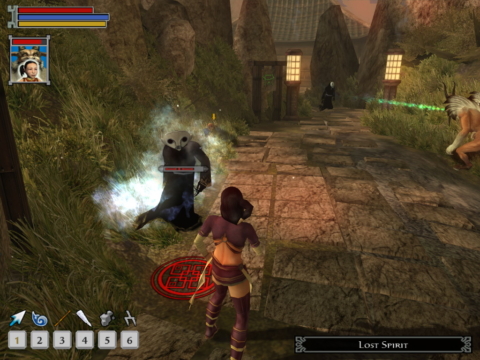
Jade Empire: Special Edition
Written by: Rik
Date posted: April 21, 2023
- Genre: RPG
- Developed by: Bioware/LTI Gray Matter
- Published by: Electronic Arts
- Year released: 2007
- Our score: 7
What started as a resolution to bloody well finish Mass Effect 2 has led me on a few adventures: to the end of the trilogy, in the first instance; then to explore an earlier, more Star Wars flavoured version of the same thing; and now here, to a mid-point between the two epic space series, as part of a general root around in Bioware’s 00s oeuvre.
I’m probably still paddling in the shallow end of the studio’s work (as my mildly horrified reaction to my colleague’s suggestion that I also get stuck into Baldur’s Gate 2 would indicate), but it’s not impossible that this may all eventually lead me back in time again, as part of an extremely convoluted quest to join the dots between games that would otherwise be in a straight line. That’s not the FFG way, though: why do logical and linear when you can blunder around the timeline, almost at random, and forget most of what you learned along the way?
If we wanted to do the straight line thing, Jade Empire would arguably still represent a bit of a detour on the path from Knight of The Old Republic to Mass Effect: very much recognisable as a relation of its more celebrated siblings, with some familiar tics and design choices, but also representing an exercise in trying out something new, both in terms of setting and approach. We’re in space no more, and instead find ourselves in a fictionalised version of ancient China, practising martial arts in an isolated village and beating up other students who seem mildly resentful of your status as the master’s favoured student. In time-honoured tradition, a bit of local trouble soon escalates into a quest that spans far and wide, dotted with encounters with new allies and battles with powerful enemies.
As a relative novice (albeit a fairly old one), one thing that I’m still to get used to with these kinds of games is the fact that you seem to have to get about five hours in before you really understand how everything works. By which point, you’ll already have been asked to make several decisions about your character, including the initial build and how to invest levelling-up points to develop powers as they become unlocked. Do you want a physically strong character, one skilled in magic, or one skilled with weapons? Do you want to fight with a sword, or a staff? Which martial arts style do you want to be trained in? (I dunno, man, it depends how good they all are and what we’re going to come up against later, I guess). Is this bit just hard, or have I made some kind of crucial wrong decision earlier that I’ll come to regret? And so on.
But, for better or worse, going with something fairly balanced, on the default difficulty setting at least, is fairly low-risk, allowing you to invest more selectively once you get far enough in to work out how you want to play. It doesn’t help that it’s all dressed up in ancient/mystic-style language, although it seems churlish to complain when on paper it’s not all that different to the made up space guns and laser swords that are apparently so much easier for me to understand.
The three primary attributes of Body, Spirit and Mind influence in combat your Health, Chi (magic, which can be used to heal yourself as well as attack enemies) and Focus (weapon skills, plus a limited ability to slow down time) respectively. Body and Spirit also affect in conversation your ability to Charm; Body and Spirit determine Intimidation options; and Mind and Spirit contribute to Intuition. (In other words, do you want to use flattery, fear, or logic to get what you want?) Powers can also be boosted by gems found or bought as you progress, and installed on your mystical amulet according to your preferences. As you find more pieces of the amulet (a powerful artefact broken into pieces and scattered across the land? In an RPG? Never!), you can add more gems. Finally, each combat discipline (martial arts, magic, weapons) comes with various styles to unlock, learn and level up as appropriate.
The fighting itself, particularly using martial or weapon styles, is a fairly straightforward system based around three moves – attack, block and strong attack – with a rock-paper-scissors approach meaning strong attacks can get through a block, but are interrupted by a standard attack. The use of magic is the only one that doesn’t require you to get close to your opponent, flinging ice or rocks at them from a distance (or holding them in place with a strong attack), while it can also be used to briefly transform your character into a great big demon that can rip enemies to shreds. Some enemies are immune to certain weapon styles, meaning some diversity in your investment of points is a sensible idea.
Unlike KOTOR, you’re in direct control of your actions during battles, rather than planning while paused and cueing them up in advance, and the whole thing plays a bit like a basic beat ’em up, which becomes a bit of a clickfest if you’re using the default mouse and keyboard (controllers are supported, although there’s no automatic recognition of a 360 pad, and you’ll have to map the buttons yourself). It’s all quite satisfying when you get the hang of it and are able to pummel some weaklings with ease, especially when making gratuitous use of the double-tap-to-dodge feature, which can send you somersaulting over the heads of dozy opponents and able to strike them from behind while they get their bearings.
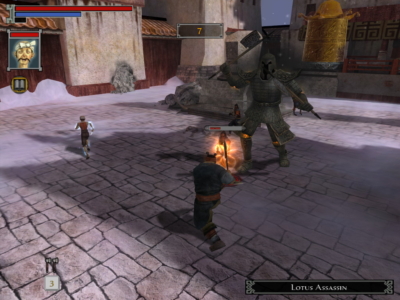
You briefly take control of other characters at various points. Here we’re battling as The Black Whirlwind, while our sidekick, Henpecked Hou, makes a run for it.
In between all the fighting, there is conversation and other questing, as you slowly gather allies who join your party and offer various levels of support to you, both in discussions and in combat. There’s an earnest hometown friend, a mysterious guilty-looking stranger, an eccentric scientist, a child who transforms into a demon, and a man who keeps going on about his overbearing wife, as well as a selection of other fairly generic fighters. You can only choose one companion to accompany you in battle, and you can neither view nor level up their stats, with only a brief menu summary and your own observations to aid you in your evaluations. My own perspective was that they were all fairly hopeless in battle, and I favoured those who were most useful in a support role, which means they stand back from the fighting and – for example – replenish your Chi or Focus while you try and kick ass.
They all have their moments, although their reduced status seems destined to make you forget about some of your companions completely at various points. Another part of the problem is that there’s no big spaceship to convene on between missions: although your party does travel between locations in a big flying machine (allowing you to participate in a slightly iffy top-down shooter, if you so choose, although these bits can be skipped), these sections don’t provide much of a narrative interlude, and instead you’re required to talk to your party at a camp that’s set up in each hub. I found it quite easy to coast along without thinking about the wider set of companions, and that periodically checking in on them is necessary to further explore their backstory and move your relationship forward. As such, while I understand that there are romance options available, I failed to see any evidence of them, with my belated chattiness towards the end of the game clearly not enough to thaw relations with any potential partners.
The general ‘vibe’ was a little bit on the zany side for me, although I know I risk sounding like a humourless man who only has time for po-faced space battling by saying so. None of the characters struck me as particularly compelling, and in some cases they were actively annoying. I did quite like Wild Flower, the child who turns into a demon, but The Black Whirlwind, who struck me as a human prototype of Wrex from Mass Effect, came across as fairly basic, violent and boorish rather than some kind of charming, rogueish antihero. For those used to forming some kind of attachment to their wider party, there may well be a similar disconnect here.
The story has some moments of inspiration: a spell undercover working for the Lotus Assassins, the Imperial Stormtroopers of this particular world, during which the extent of an evil plan to turn the poor into an army of golems is uncovered, injects the tale with some urgency and menace, but it arguably comes a little late in the piece, and after a pretty slow-burning start. Generally, though, it fails to quite scale the epic heights upon which its sights are clearly aimed. Side quests provide some humorous interludes, including a bizarre cameo from UK comedy genius/GB News nutter John Cleese as a British Lord armed with offensive attitudes (life imitating art…?) and a blunderbuss, but often feel less than essential.
The morality system initially gives an indication that it might be a little more complicated than good or evil, light side or dark side, or Paragon/Renegade. However, that could potentially again be down to the slightly flowery language with which it’s introduced, because it turns out to not be much more complicated than that, with the evil option simply spanning the full range of needlessly rude and threatening verbal responses and borderline psychotic behaviours and actions. Clearly, that kind of thing might appeal to some, with online testimonies reporting that you can take things to some truly dark and distressing places should you be so inclined, but the path of least resistance is clearly to be a quite chipper and positive hero character. Each ‘side’ brings unique abilities, although it’s a little difficult to see the appeal of a second playthrough on this basis alone.
Possibly that’s because you end up with a big enough toolbox at your disposal by the end of the game already, and at the standard difficulty, it’s more than enough to see you through to the end. As long as you invest in at least one of each of the main styles – martial, weapon, magic and transformation – it’s mainly a case of cycling through them and finding out what works best with each opponent. Some enemies are still fairly annoying – I groaned whenever fighting ghosts and spirits, who seem particularly resilient, although I guess it should be hard to fight a ghost given that your fists and weapons should technically pass straight through them.
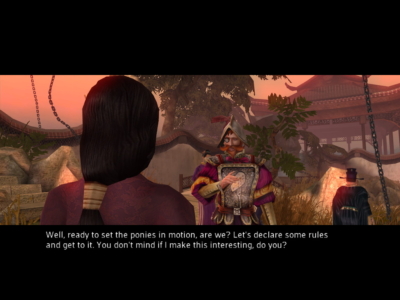
The Cleese character is called Sir Roderick Ponce Von Fontlebottom, which gives you an idea of the tenor of his contributions.
Towards the end of the game there was one transformation style in particular that seemed fairly overpowered, stomping enemies with ease, and when the fighting got a bit tedious it was hard to resist invoking it for an easier time. The novelty of the combat does start to wear off after a while, and when you’re outnumbered or outmatched, some of the idiosyncrasies, including a slightly fiddly targeting system and the slow ‘area attack’ mechanism used to clear a group of enemies in your immediate vicinity, may well start to grate.
Sloppiness due to repetition, particularly omitting to block in favour of simply hammering away with attacks, is probably your biggest enemy, although possibly at higher difficulty settings more subtlety may be required. Perhaps it’s understandable that the transition from the more considered system used in KOTOR to one with more active involvement in the fighting would be a little bumpy, and it’s certainly not actively bad, just a bit too much like a not particularly memorable incarnation of a 2D scrolling brawler at times. (I imagine… I mean, I’ve only ever really played Double Dragon on the Atari ST, which certainly meets those criteria).
History seems to suggest that Jade Empire is the odd one out of this Bioware period, with the studio later lamenting its release on the original Xbox, towards the end of its life, rather than on the more powerful 360. This souped-up ‘Special Edition’ is polished up nicely, although it still seems like the generation straddling game that it is rather than a genuine 360-era title. (It does support widescreen resolutions, by the way, I just preferred 4:3 on this occasion). The only real bum note is, as with some of the other Bioware games, the blurry video clips, which compare poorly with the in-game graphics. I also had to download a fix and fiddle with some of the .ini files before the game would behave, and it seems odd that such things are necessary in the modern world of digital purchases and downloads.
Jade Empire is a decent romp, but one that I didn’t quite take to as much as I might have liked. Whether that’s down to personal taste regarding the setting, or something more fundamental, it’s hard to say, but it seems to take a while to get going and, even when it does, it just doesn’t seem to quite create the same momentum as the likes of KOTOR or Mass Effect. Fans of those games will likely still find plenty to recognise and enjoy here, but for me the slightly underwhelming story, occasionally wacky tone, and combat that eventually becomes noticeably repetitive each take a little bit of the gloss of what is otherwise a pretty enjoyable game.

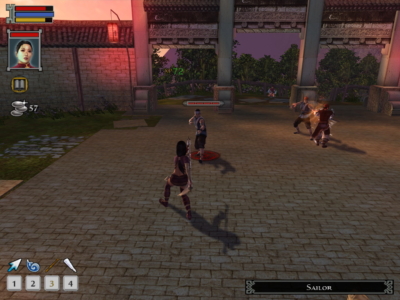
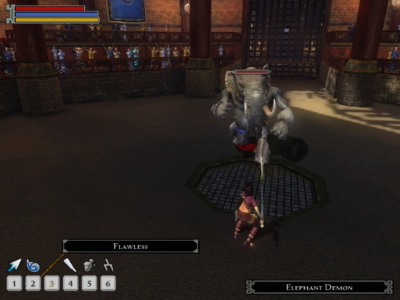
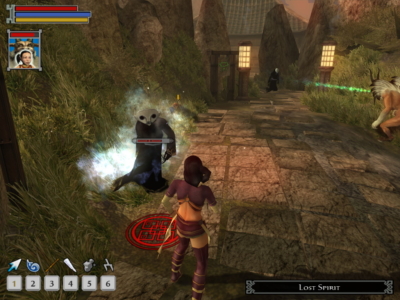
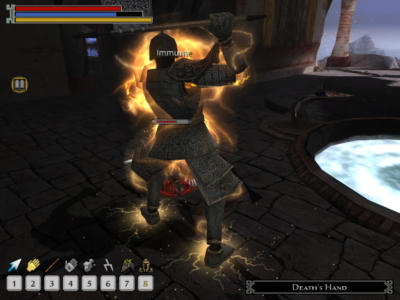

 Posts
Posts
Really enjoyed following your journey through the 2000s era Bio-verse! Guess the question now is if Dragon Age is in the cards?
May 1, 2023 @ 3:30 am
Thanks JMan!
Dragon Age would seem to be a logical next step… which probably means it’ll happen in 5 years’ time (in between Baldur’s Gate II and Neverwinter Nights).
May 1, 2023 @ 5:38 pm